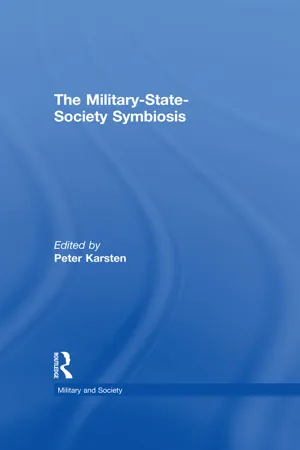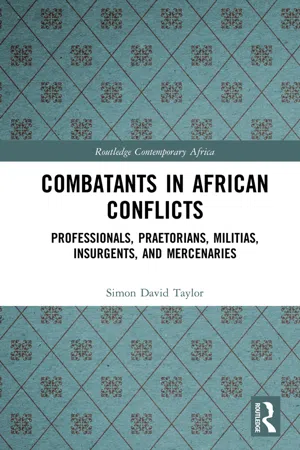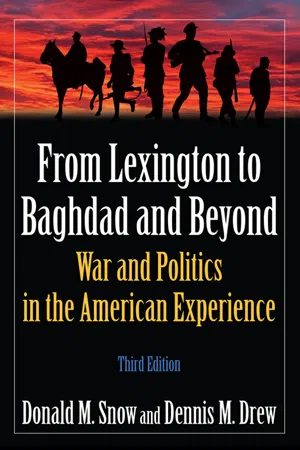Colonial Militia
Colonial militia refers to a military force composed of ordinary citizens who were trained to defend their communities during the colonial period in America. These militias played a crucial role in protecting the colonies from external threats and were often called upon to support regular troops during times of conflict. The colonial militia system laid the groundwork for the development of the American military tradition.
6 Key excerpts on "Colonial Militia"
- eBook - ePub
- William C. Banks, Stephen Dycus(Authors)
- 2016(Publication Date)
- Harvard University Press(Publisher)
...Their evolution as distinct, substantially self-reliant, yet interdependent legal entities paved the way toward eventual statehood and the federal constitutional structure. This same development strongly influenced the organization and domestic use of military forces. Colonial Militias began to form with the arrival of the first settlers. They were typically organized into company-sized units in local townships or counties. Qualifications for citizen soldiers varied among the colonies, but membership might be required for all white males between the ages of 18 and 45 who paid taxes and owned property, with exceptions for some occupations. Regular but largely ceremonial drills were required, but seldom active service. Militiamen were supposed to supply their own equipment and arms, although few of them owned guns. Colonial legislatures set policies for the troops, and governors appointed the officers in an early American form of patronage. The colonists created cross-border militia confederations to fight off attacks from Native Americans. Some towns also formed specialized units, called Minutemen. These were elite militia personnel—somewhat akin to modern U.S. special forces—who were usually younger, better trained, and chosen for their ability to turn out for a fight on very short notice, hence the name. The militias were not involved in the conflicts fought among European powers in North America. British military leaders recruited wartime forces episodically, as the need arose, and disbanded them when the fighting ended. Even the largest of these conflicts, the French and Indian War of 1754–1763, was fought by “war service only” battalions of volunteers recruited to fight independently or alongside British troops...
- eBook - ePub
- Peter Karsten, Peter Karsten(Authors)
- 2013(Publication Date)
- Routledge(Publisher)
...A New Look at Colonial Militia John W. Shy * T HE subject of the militia has produced some passionate writing by American publicists, soldiers, and historians. Defenders of the militia—those who believe that a universal military obligation is the proper way to defend a society—are fond of stressing that only when free men must themselves fight to protect their liberty are they likely to remain free. The Colonial Militia, in particular, represents the happy uniqueness of America, where Englishmen in the seventeenth century revived this military relic of the middle ages just as in Europe it was sinking beneath the superiority of the politically dangerous mercenary army on the battlefield. Critics of the militia—many of them professional soldiers—point a different moral, one that rests on the apparent inefficiency of militia in combat, and on the way that the myth of defense by militia led again and again to tragic unpreparedness for war. There is one point, however, where critics and defenders appear to agree: it is on the assumption that the militia, especially the Colonial Militia, is a fairly static institution; once its simple theory of organization has been described, there seems little need to watch it as closely for signs of deviation and change as one would watch, say, political institutions...
- eBook - ePub
American Military History
A Survey From Colonial Times to the Present
- William Thomas Allison, Jeffrey G. Grey, Janet G. Valentine(Authors)
- 2020(Publication Date)
- Routledge(Publisher)
...Under such arrangements, then, militias functioned as both an initial reaction force and a social stabilizer. Militia service provided a sense of security, established and maintained social parameters, and satisfied the expectations of civic duty. Much overshadowed by its defensive purpose was the effective job militia performed as police, functioning as an overseer of internal order in a colony. Troubled times frequently brought riots and, as in the case of Virginia in 1676, occasional rebellion. Theft and violent crime plagued port cities. Economically displaced vagrants passed through towns and villages, rousing the suspicion of residents. Some drifters were actually impressed into militia service. To protect themselves from these threats, many communities recruited small numbers of militia to serve as watch patrols. Like militia, the colonial watch had its origins in England and was also transported to America by English colonists. In the southern colonies, militias and the watch evolved into slave patrols, which roamed the countryside on the lookout for runaway slaves and signs of slave insurrection, much as the old ranger patrols had done against the Indian threat. Even in New York City, militia helped put down a slave revolt in 1741. In essence, militia came to serve more as a ‘hue and cry’ response force. Occasionally, militia could not be used to quell disorder because militiamen themselves made up much of the disturbing party. Such was the case in the Carolinas when roving militia patrols known as regulators grew into a law unto themselves and had to be reined in by legitimate legal authority. Indeed, the militia came to epitomize the precarious balance between civil order and the abuse of military authority. Militia also served as a training mechanism and manpower reservoir for colonial expeditionary forces...
- eBook - ePub
Combatants in African Conflicts
Professionals, Praetorians, Militias, Insurgents, and Mercenaries
- Simon David Taylor(Author)
- 2022(Publication Date)
- Routledge(Publisher)
...Thus, if the state becomes tyrannical, the militia may oppose the state. If a militia does form a closer relationship with the state, especially in terms of supplies and training, the militia can be expected to undergo a process of what this paper terms ‘evolutionary militarisation’. Evolutionary militarisation refers to a process whereby a combatant type responds and adapts to the conditions of conflict in order to survive. The legitimacy of militias as combatants is based on their close ties to the communities they are supposed to defend, the regulation of the group through a recognisable command and control structure, and the reason for their deployment, which can include acting against a tyrannical state. Militias and the American Experience The American War of Independence was perhaps one of the first instances where militias were used on a large scale and as a central component of the war effort, and they played a prominent role in the political, social, and military lives of the colonists. 40 As an English colony, the Americans had adopted a militia defence system for their earliest settlements, because the militias had played a prominent part in the English Civil War, and the lessons learnt from this civil war and the War of Independence were to have a lasting impact on the politics of American systems of defence. The Federalist Papers The Federalist Papers 41 authors, James Madison, and Alexander Hamilton in particular, detail several arguments in defence of constitutional democracy for the newly formed United States. They aimed to address concerns that the Antifederalists may have in supporting the new Constitution, especially regarding the roles and threats of armed forces and militias in the States...
- eBook - ePub
From Lexington to Baghdad and Beyond
War and Politics in the American Experience
- Donald M Snow, Dennis M. Drew(Authors)
- 2015(Publication Date)
- Routledge(Publisher)
...That most of these battles were not as successful as we remember them, nor as militarily significant, and that they were interspersed with a series of military reverses that were nearly decisive, (e.g., the battles of New York and Brandywine Creek) have faded from the popular mind. An objective evaluation of the war itself shows that militarily it was no better than a draw for the Americans, who were aided by mediocre British generalship. In addition, the revolutionary experience did much to create the myth of the militia tradition in America. When the war began almost accidentally at Lexington and Concord, the only military forces available to the rebellion were militia units. Throughout the war’s conduct, militia units played an important role (especially the so-called revolutionary militia, about which more will be said later). Colonial success created the myth that militia was effective against regular troops and that the United States did not need a standing armed force of any size during peacetime. The militia could be quickly mobilized and hold its own until a regular army could be fielded to carry the day. Once the war was over, demobilization could be rapidly accomplished (in 1784, a year after the peace treaty was signed, the standing army consisted of 80 regulars whose sole purpose was to guard military supplies). The performance of militia units in the Revolution, viewed carefully, hardly justifies that level of faith, but it created a tradition that still leaves Americans at least slightly uneasy about maintaining a large standing force during peacetime. That the war was not exactly what we choose to remember does not depreciate the importance of the struggle. Although the American Revolution may not have been a major military struggle, it was a major political event. There were military lessons to be learned...
- eBook - ePub
- Howard H. Peckham(Author)
- 2014(Publication Date)
- University of Chicago Press(Publisher)
...The other colonies enacted similar laws. At first, one-third of the militia was equipped as pikemen, and two-thirds as musketeers. The former being found useless in the woods, all became musketeers equipped with sure-fire matchlocks, replaced by flintlocks by 1675. Carbines and pistols were also used. Each town was required to have a band or company, and those men who could afford to furnish horses were organized into troopers or cavalry. Usually each company elected its own officers, although the governor was commander in chief. Only Pennsylvania had no militia system. The professional companies from England, unknown before 1674, had again disappeared. Now in this first joint war effort, the American amateurs, experienced principally in Indian conflict, would be tested. Canadians were similarly organized in provincial militia. Un der the seigniorial system, military service was a duty that the tenants owed the landowners, and the landowners owed the king, a feudal concept. Since it was a familiar condition of colonial life, there was little objection to it. In each parish an appointed captain led his militia company; in time of action companies were organized into battalions and field officers appointed. As regulars, Canada had the various companies of La Marine Regiment. Its strength fluctuated between five hundred and perhaps twelve hundred men, frequently composed of recruits of the poorest sort shipped over from France. The Canadian government could also marshal Indian allies and call on missionaries or coureurs de bois (fur traders and adventurers in the forest) to lead them. No prime French regulars were available to Canada. BOLDNESS ON BOTH SIDES Since the Iroquois had delivered a staggering blow to Canada with impunity and forced the French to relax their hold on Lake Ontario, the next move was clearly up to the Canadian government...





